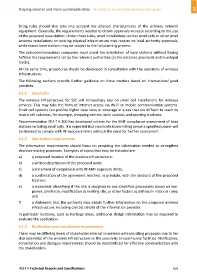Page 639 - Shaping smarter and more sustainable cities - Striving for sustainable development goals
P. 639
Siting rules should also take into account the physical characteristics of the wireless network
equipment. Generally, the requirements needed to obtain approvals increase according to the size
of the proposed base station. Under these rules, small installations such as small cells or other small
antenna installations on existing physical infrastructure may require no local authority approvals,
while macro base stations may be subject to the full planning process.
The radiocommunication companies must avoid the installation of base stations without having
fulfilled the requirements set by the relevant authorities (at the national, provincial and municipal
levels).
At the same time, procedures should be developed in consultation with the operators of wireless
infrastructure.
The following sections provide further guidance on these matters based on international good
practices.
9.1.1 Small cells
The wireless infrastructure for SSC will increasingly rely on small cell installations for wireless
services. This may take the form of Internet access via Wi‐Fi or mobile communication systems.
Small cell systems can provide higher data rates or coverage in areas that are difficult to reach by
macro cell solutions, for example, shopping centres, train stations and sporting stadiums.
Recommendation ITU‐T K.100 has developed criteria for the EMF compliance assessment of base
stations including small cells. It is expected that small cells transmitting below a specified power will
be deemed to comply with RF exposure limits without the need for further assessment.
9.1.2 Information requirements
The information requirements should focus on providing the information needed to strengthen
decision‐making processes. Examples of topics that may be included are:
a) a proposed location of the wireless infrastructure;
b) a written description of the proposed work;
c) a statement of compliance with RF‐EMF exposure limits;
d) a confirmation of the agreement reached, in principle, with the landlord of the proposed
location;
e) a statement identifying if the site is designed to use simplified procedures based on low‐
power, small‐size, modification to existing site, or other factors as defined in national rules;
and
f) a statement that the authority may obtain further information on the proposed wireless
infrastructure, including contact details of the information provider.
In particular locations, such as heritage areas, additional design information may be required to
evaluate the application.
9.1.3 Notification and consultation requirements
There may be differing levels of stakeholder interest in wireless antenna siting proposals due to the
characteristics of the wireless infrastructure or the proximity to community facilities. Notification,
consultation and dialogue requirements should be standardized for effective communication with
the stakeholders.
ITU‐T's Technical Reports and Specifications 629

